Pentagon Chief Meets Panama President
US to Reclaim Panama Canal, Curtailing China’s Influence
Historic Visit to Panama
Panama City: In a landmark development, the United States has announced its intention to reclaim influence over the Panama Canal, a strategic waterway of global significance. US Secretary of Defense Pete Hegseth made this declaration during a rare and pivotal visit to the Central American nation, marking the first time a US defense secretary has visited Panama in decades.
Meeting with Panamanian Leadership
During his visit, Secretary Hegseth held a closed-door meeting with Panamanian President Jose Raul Mulino. The discussions centered on the growing concern over China’s investments and involvement in and around this crucial maritime passage, which links the Atlantic and Pacific Oceans. The meeting underscored Washington’s commitment to strengthening its relationship with Panama and ensuring the security of the canal.
A Joint Effort to Secure the Canal
Secretary Hegseth emphasized the need for deepened security cooperation between the US military and Panamanian forces. “Together, we (Panama and the US) will take back the Panama Canal from China’s influence,” he stated in Panama City. The announcement signals the end of China’s influence over the canal, a move that aligns with President Donald Trump’s strong rhetoric on the matter.
Panama at the Forefront
Hegseth praised President Mulino for his understanding of the “threat from China,” highlighting Panama’s leadership role in addressing the canal’s security concerns. This collaborative approach aims to ensure that the canal remains secure and accessible to all nations, free from external manipulation.
Strategic Implications and US Military Preparedness
While Hegseth focused on diplomatic and security measures, President Trump has not ruled out the use of military force if necessary. Reports suggest that the Trump Administration has already requested military options to ensure continued access to the canal, emphasizing its strategic importance.
Historical Context and Recent Developments
The Panama Canal, constructed by the United States over a century ago, was transferred entirely to Panama in 1999. This recent development marks a significant shift, with the US military expected to increase its presence and coordination with Panama’s security agencies to counteract Chinese influence.
Panama’s Strategic Realignment
In February, President Mulino announced Panama’s decision to exit China’s Belt and Road Initiative, marking a shift in the nation’s foreign policy. Additionally, he has supported US immigration policies by accepting deportation flights and working to curb illegal migration through Panama’s dangerous Darien jungle.
Significant Economic Moves
In a noteworthy economic move, US firm BlackRock led a deal to acquire the majority of the $22.8-billion ports business of Hong Kong conglomerate CK Hutchison, including its ports on either end of the Panama Canal. President Trump celebrated the deal as evidence of the US “reclaiming the Panama Canal,” although China criticized the transaction and announced an antitrust review.
Military Considerations and Global Impact
Military experts highlight the canal’s strategic importance, particularly in the event of conflict in Asia, as it facilitates the movement of US naval ships between the Atlantic and Pacific Oceans. With China’s presence around the canal, there is potential for surveillance and disruption, underscoring the significance of US efforts to secure this vital waterway.

